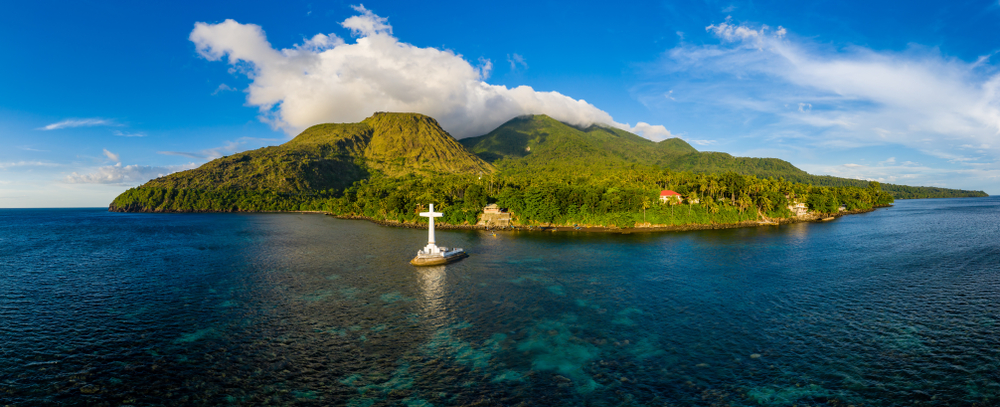
CAMIGUIN by Diving Squad - Traveller's Guide
Ahh Camiguin. Wait…what’s a Camiguin?!
Well you see…Camiguin is a 229 km squared island 10km off the northeast coast of Mindanao; a somewhat obscure part of the Philippines that’s considerably off-the-beaten track.
But with 7 volcanos, Camiguin actually has the highest volcano density of any island in the world; making it a visually spectacular place to visit with epic treks, waterfalls and pristine nature.
There’s also some great scuba diving to be had with awesome coral, schooling giant jacks, turtles and all manner of reef fish.
However, I’ll tell you a secret: not all Camiguin dive sites are equal – and some dive centres try to sell you the less good ones!
For example, maybe you’ve heard of the sunken cemetery dive site: it’s actually not even recognisable as a sunken cemetery anymore and pretty underwhelming!
In this epic guide of awesomeness I’ll explain everything you need to know about scuba diving Camiguin: the best dive sites; other things to do, when to go, how to get there and more.
This is all based off my dive mission to Camiguin over April 2023 so you can rest assured this guide comes from first hand knowledge and experience. Ok…read the f*ck on!
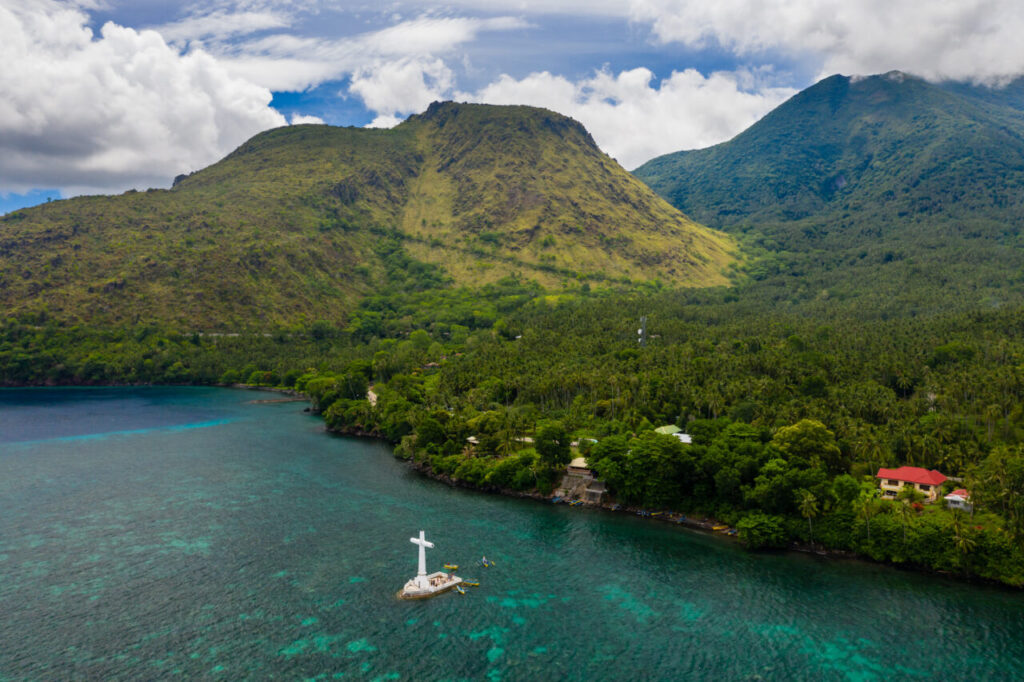
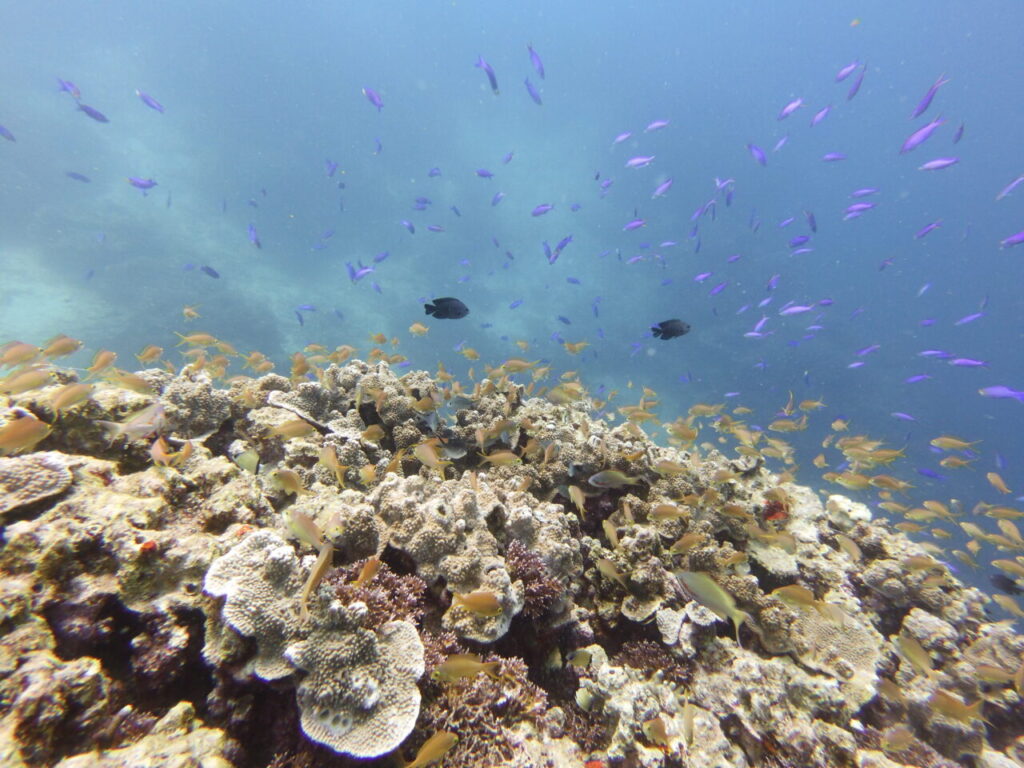
What you can See Diving Camiguin
#1 Amazing Soft Coral Gardens
Some of the best dive sites around Camiguin are those featuring extensive soft coral gardens with enormous neon green and bright orange sea fans as well as frogfish, seahorses, pipefish and nudibranch.
In some of these soft coral gardens further out to sea (like the dive site “black forest which is sometimes a drift dive), you also have a good chance of seeing larger pelagic fish.
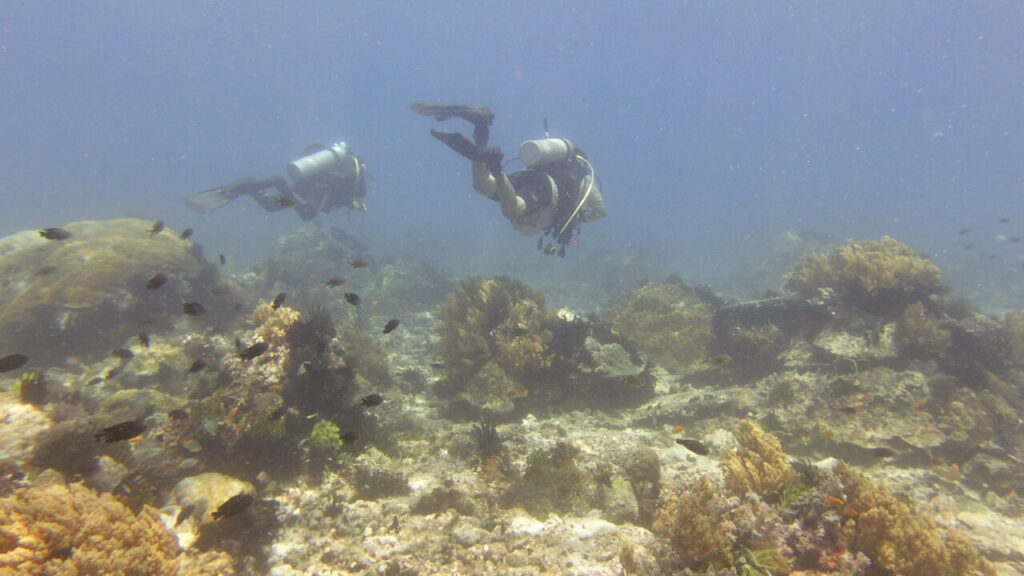
#2 Volcanic Rock formations
Known as “the island born of fire” Camiguin has seven volcanos. It’s therefore not surprising that there are some awesome underwater rock formation on several of the dive sites, especially round the dive site “old volcano” where divers can see many sharp pinnacles formed by volcanic lava.
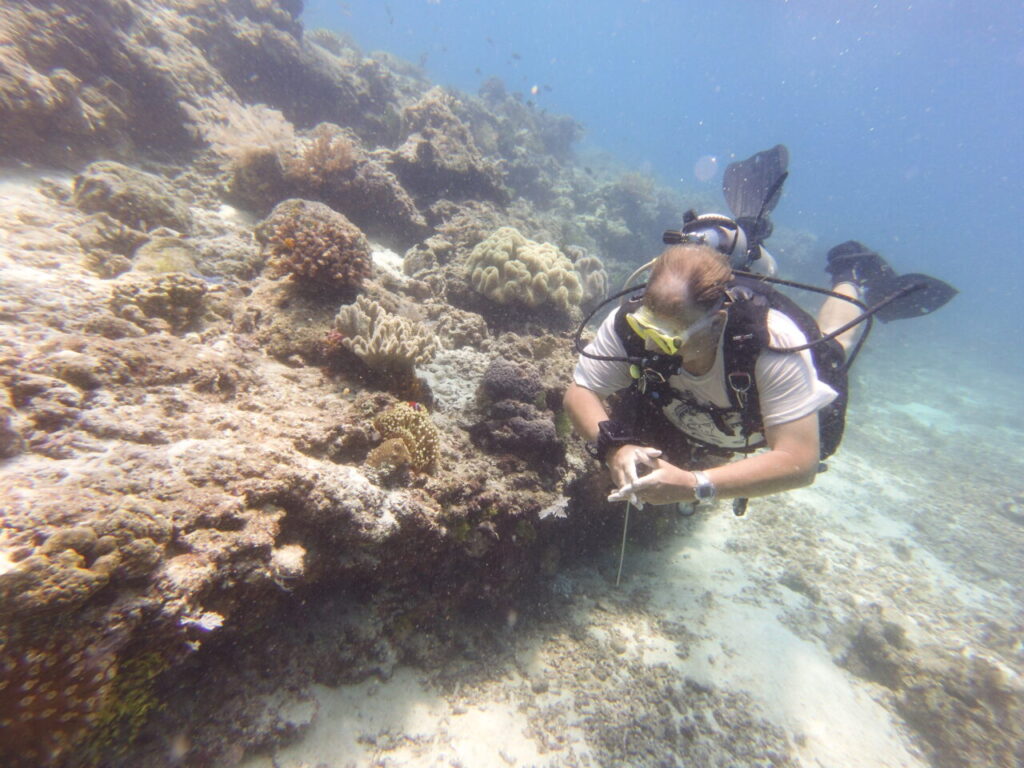
#3 Larger Pelagic Species
Although definitely not guaranteed, larger pelagic species are sometimes seen around some dive sites including eagle rays and whitetip reef sharks – and very rarely manta rays and whale sharks as well!
#4 Schooling Jackfish
Around the dive site Mantigue Island, it’s very common to see schools of jackfish: a large species of pelagic fish with shiny silver bodies and powerful, muscular bodies.
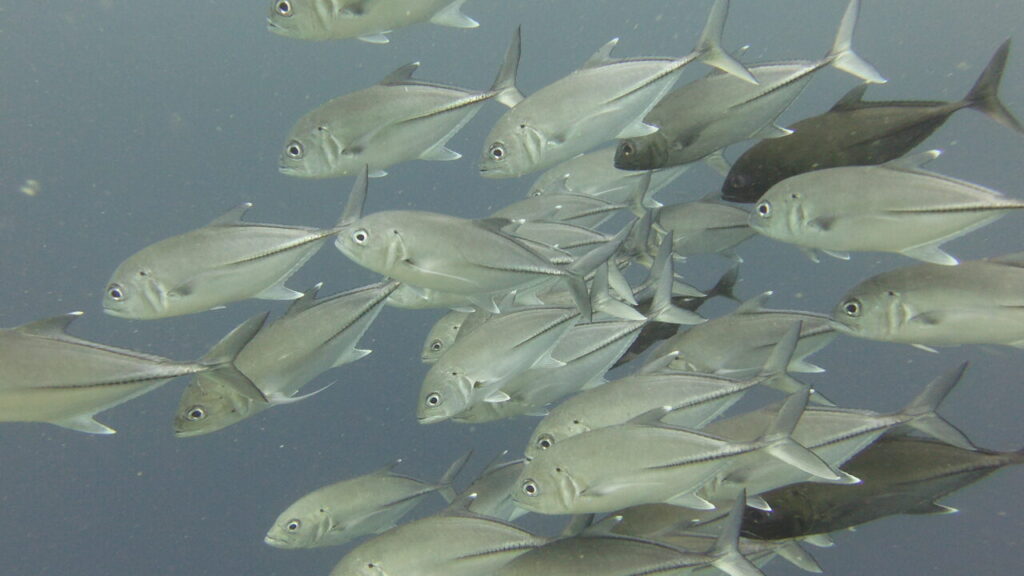
#5 Turtles
There’s a fair amount of turtles to be spotted when diving around Camiguin including green sea turtles and the rarer hawksbill turtle species. I saw at least one turtle on every dive!
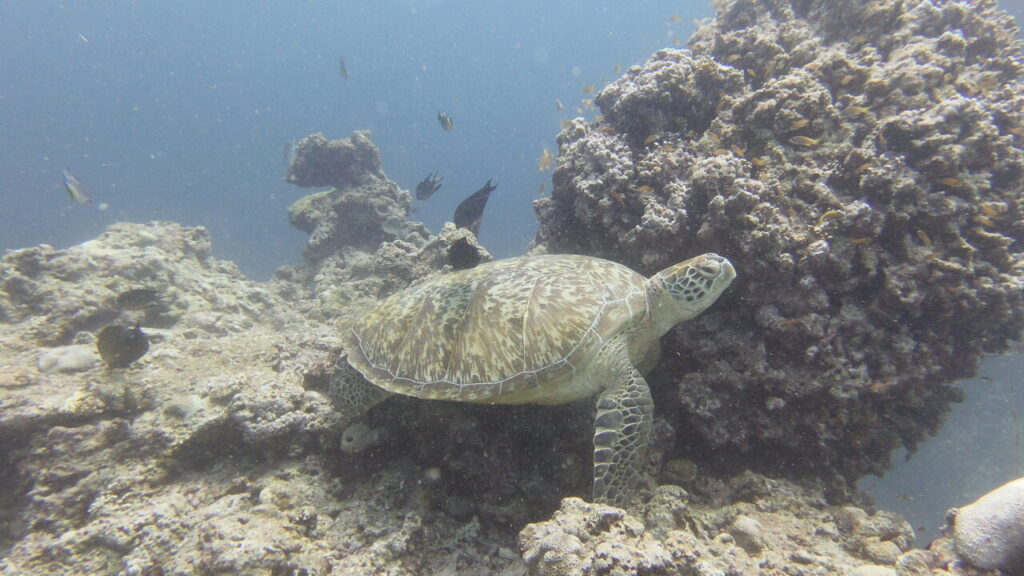
Around Camiguin there are a few dive sites that in my opinion are overhyped and not worth it. These are:
- Sunken Cemetery: This was actually one of the main reasons I went to Camiguin. I envisioned an eerie dive in which I drifted over countless gravestones as ghostly blue-glowing skeletons rose up to dance around me in an underwater rave… However, typhoons have long since knocked down all of the the gravestones and besides a cross sticking out of the water, there is absolutely zero indication that you are diving over a cemetery. Anti-climax.
- Mantigue Island: Although it’s undeniably cool that there are many jackfish here, in all other regards I found the dives sites kind around Mantigue Island to be underwhelming. The hard coral was not in great condition and the visibility wasn’t as good as other dive sites. It’s not bad diving…however half-day trips to Mantigue Island are absurdly expensive: 150% the price of other dive sites at around 6000 pesos ($107!)… which in my opinion is a massive rip-off!
Where to Stay in Camiguin
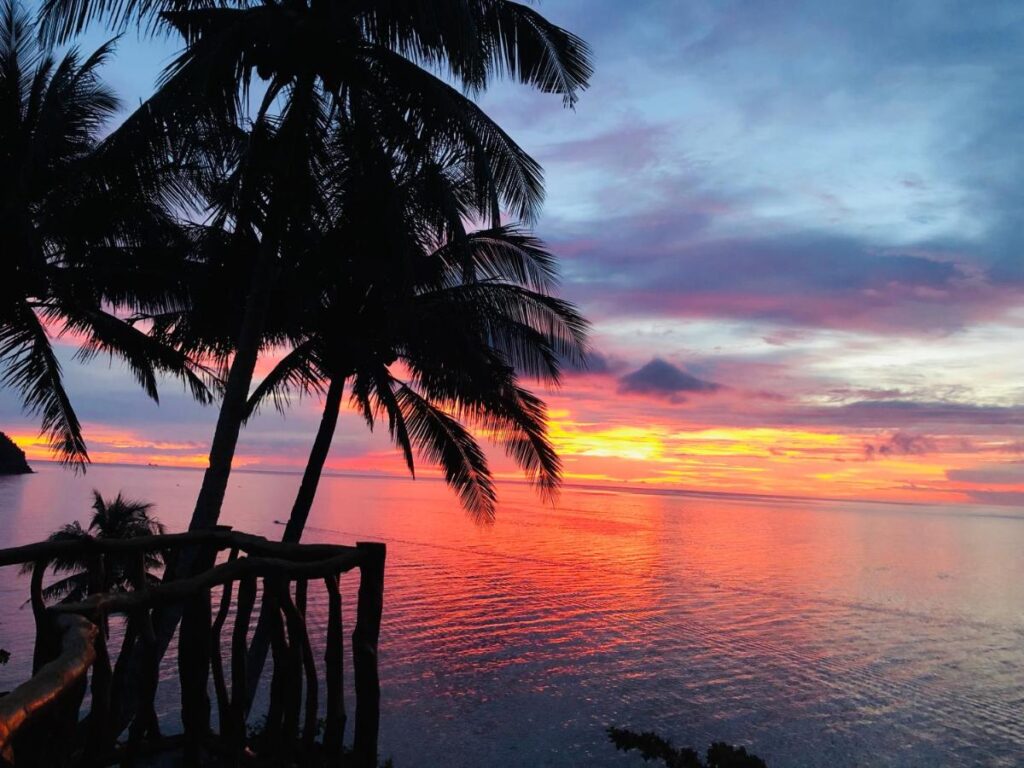
Because it’s more off-the-beaten-track Camiguin has considerably less tourist development than other more well-known Philippines dive destinations such as Bohol and Moalboal. As a result, accommodation is both more limited and more expensive.
Bare in mind that most accommodation options, restaurants and dive centres / resorts are situated along the north side of the island within close (ish – still up to thirty minutes away) proximity to Mambajao, the islands’ only “city” which actually feels like more of a town. There’s a few dive resorts along the east side of the island and they are cheaper but further from restaurants.
Here’s a short list of what I consider to be among the Best Places to Stay in Camiguin for Divers:
- LUXURY: Kokomo Dive Resort: Situated along the northeast of the island, away from the hustle and bustle of Mambajo, this is a luxury dive resort with its own swimming pool, garden and shared lounge terrace. Every room has a desk, balcony and ocean view. Check Prices.
- CHEAPEST: Red Doorz at July’s Haven: Located along the beachfront of the north side of Camiguin, this is the cheapest resort you can stay at, yet is conveniently close to a number of dive centres and restaurants. It’s a quiet and friendly setting with a restaurant and chill out zone featuring hammocks. Check Prices.
- PRIVATE VILLAS: Bintana Se Paraiso: A super-luxurious option that allows guests to stay in a luxury private villa with a swimming pool, balcony and epic ocean views. What’s really cool is that this is still part of a resort so you’re within less than a minute of the on-site restaurant and 24/7 help desk. Check Prices.
- MOST EPIC VIEWS: Camiguin Volcano Houses Panoramic House: For the most epic setting and views imaginable look no further. Set high on a hill amidst pristine nature, this 3-Star accommodation features private balconies with jaw dropping views, private balconies, a picnic area and gorgeous wooden interiors. Breakfast is available every morning and there is also a shuttle service. Check Prices.
- BEST REVIEWS: Tongatok Cliff Resort: With the highest number of consistently rave-reviews on booking.com, Tongatok Cliff Resort offers spacious apartments with balconies and mountain views amidst a peaceful setting alongside a private beach and with it’s own restaurant and dedicated staff who will help you arrange diving. Check Prices.
INSIDER TIP: If you’re staying somewhere that doesn’t’ do breakfasts, realise that virtually all cafes and restaurants only open at 9… whereas the dive centres have meet times between 8 and 8:30.
Your only option for food will be the Checkpoint: a double story, wooden block of small shops and restaurants, where you can buy cheap filipino food (rice, eggs etc) both to eat there or take as a packed lunch with you. When looking for the checkpoint on google maps, just don’t confuse it with the military checkpoint all the way in mambajao!
Camiguin Diving Season
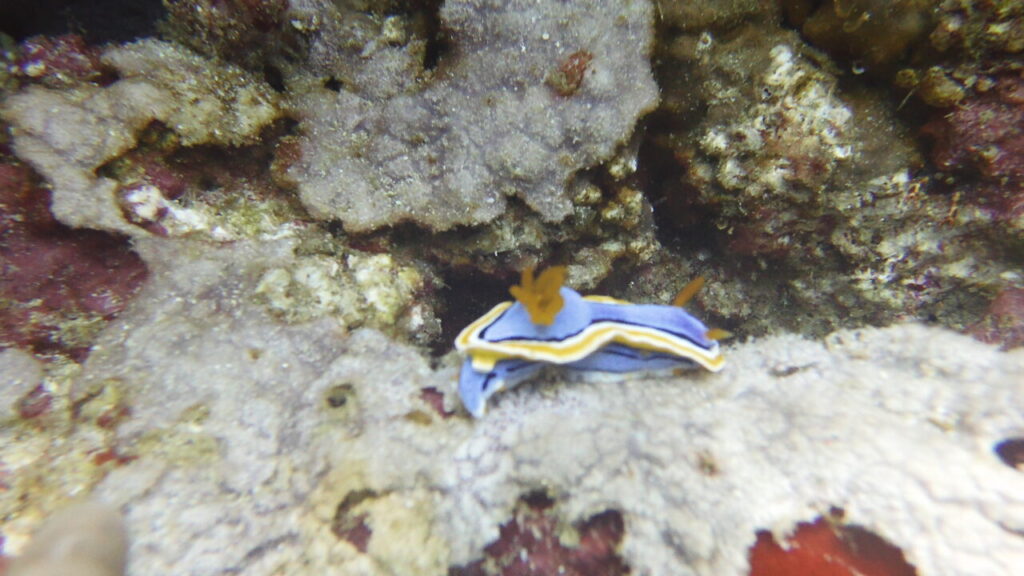
Camiguin, being Camiguin is a little different from the rest of the Philippines and has its own distinct dive season.
Generally speaking, Dry Season runs from April to November (which is rainy season in many other parts of the Philippines) and during this time divers will experience the calmest conditions and best visibility.
Between the months of December to March is Monsoon Season – heavy rainfall and rough seas can make dive conditions far from adequate although not impossible.
How to Get to Camiguin
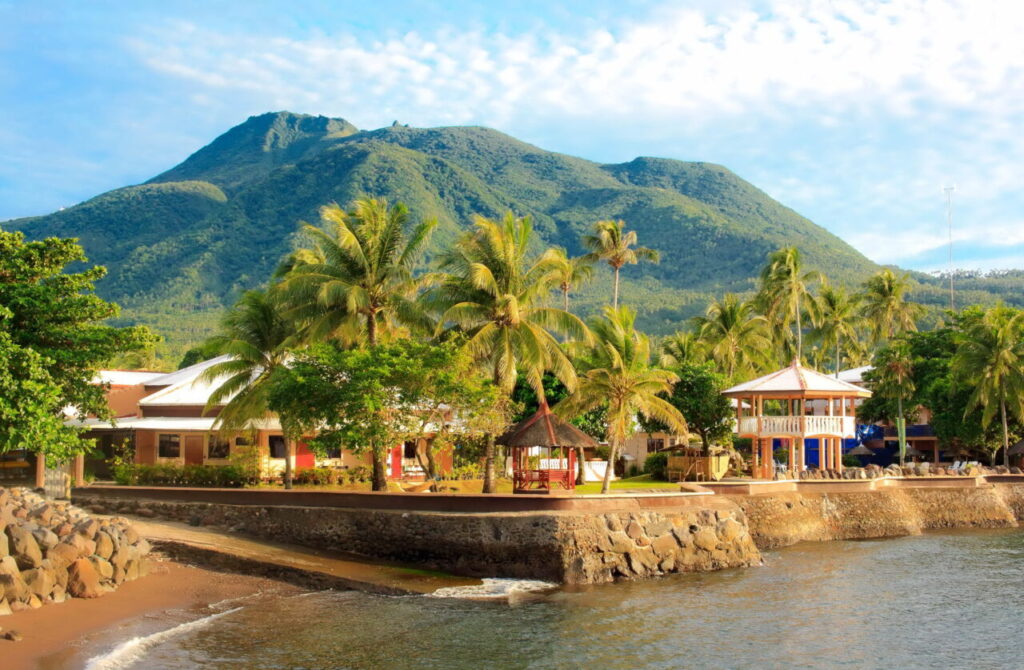
One of the reasons that Camiguin is so obscure as a traveller destination is because it’s kind of a b*tch to get to if you don’t fly! If you are willing to fly, Camiguin does have an airport, which can most easily be reached reach from Cebu airport.
However if you’re taking a ferry, the way is more complicated:
You can reach Camiguin from Bohol; however to do so you must get to Jagna port which is a two hour bus ride from Tagbilaran (which is right next to Panglao) – or about 45 minutes from Anda (which also has some great off-the-beaten-track diving).
After reaching Jagna port, it’s a four hour ferry ride, which currently depearts daily at 13:00 – but in the past has only departed on Mondays, Wednesdays and Friday’s so check the ferry schedule in advance in case it changes again!
Camiguin can also be reached via ferry from Cagayan de Oro on mainland Mindanao.
Camiguin has stricter health security than other parts of the Philippines so make sure to have downloaded and filled out your Camiguin health pass before you arrive!
Other Things to Do in Camiguin
As you’ll soon discover upon arriving in Camiguin, it is a visually spectacular island with seven mighty volcanos covered in dense jungle, waterfalls, white sand beaches and volcanic rock formations. It is a great place for mini-ventures! Here’s a few of my favourite things to do in Camiguin besides dive:
#1 Mt. Hibok-Hibok
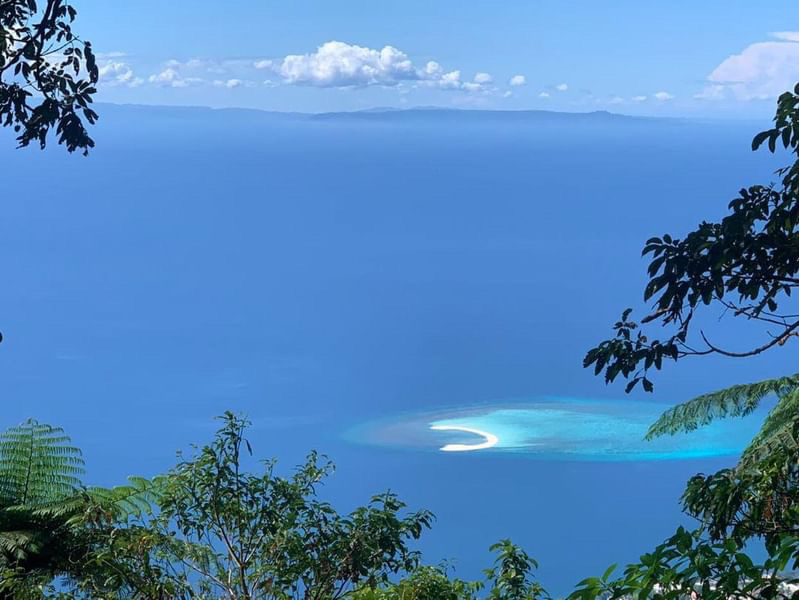
Mount Hibok-Hibok is the largest of Camiguin’s 7 volcanos and at 1,132 meters it towers over the island offering superb panoramic views. It’s a 6.6 mile trek there and back; one which starts off deceptively easy but soon becomes moderately challenging as it get ever steeper and you climb and haul your ass through dense, humid jungle.
As well as the main viewpoint from Mount Hibok-Hibok there is also a crater lake which is a very serene and mystical place indeed – you can even camp there over night to catch the sunrise the next day.
It generally takes around 5 hours to go there and back and you have to take a guide – trust me on this, you’ll be glad you did as the “trail” becomes totally obscure through thick, dense jungle. This trek is best started early in the day to avoid the heat!
Without a doubt, this was the coolest thing I did on Camiguin, besides dive although it left me totally wiped out. Remember to hydrate!
#2 Mount Vulcan
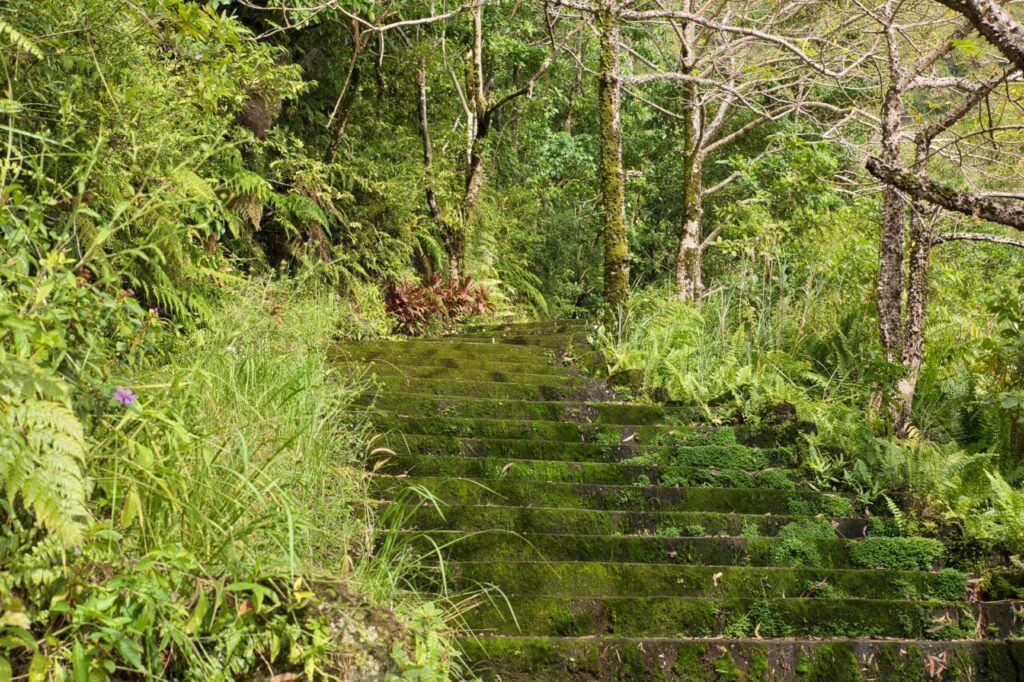
A much tamer trek, which takes around an hour there and back again is Mount Vulcan, a series of steps leading up to mount Vulcan aka the old volcano. It’s relatively easy and you get some decent views from the top, although not so spectacular.
There’s also a bunch of statues depicting Jesus’ cross-burdened trek which are of fairly high religious importance for the loca.s.
To be honest, when I did this trek I was under the impression that you could get to the top of Mount Vulcan as were several other travellers I met along the way, but this is no longer possible so you don’t get any panoramic view and there’s quite a lot of tree coverage as well so you only get a decent view from a few small places in the route.
Still, it’s a semi-decent place to go around sunset time and whilst a fairly easy trek, it’s still a great calves-blasting workout!
#3 Waterfalls
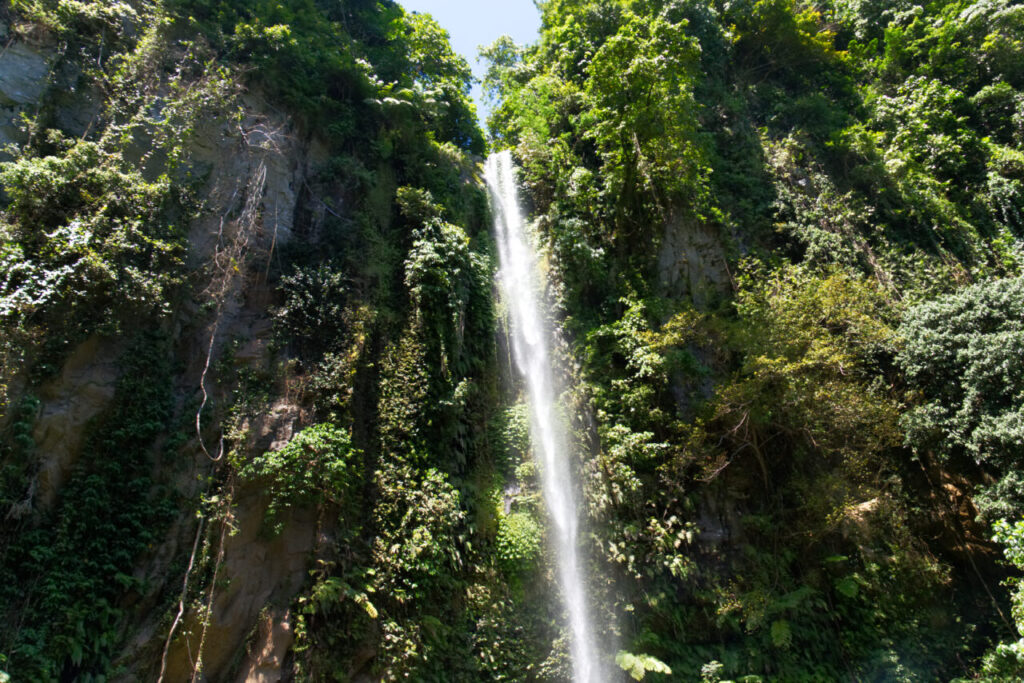
Falls, falls, falls! It seems that every part of the Philippines has them. If you’ve already been to loads of waterfalls elsewhere in the Philippines you may be tempted to skip them here in Camiguin – however I strongly recommend that you at least make it to Katibawasan falls which was one of the largest and most impressive waterfalls I’ve seen in all of Philippines.
There’s also the smaller, in my opinion less impressive Binangawan and Tuasan falls.
#4 Ardent Hot Springs
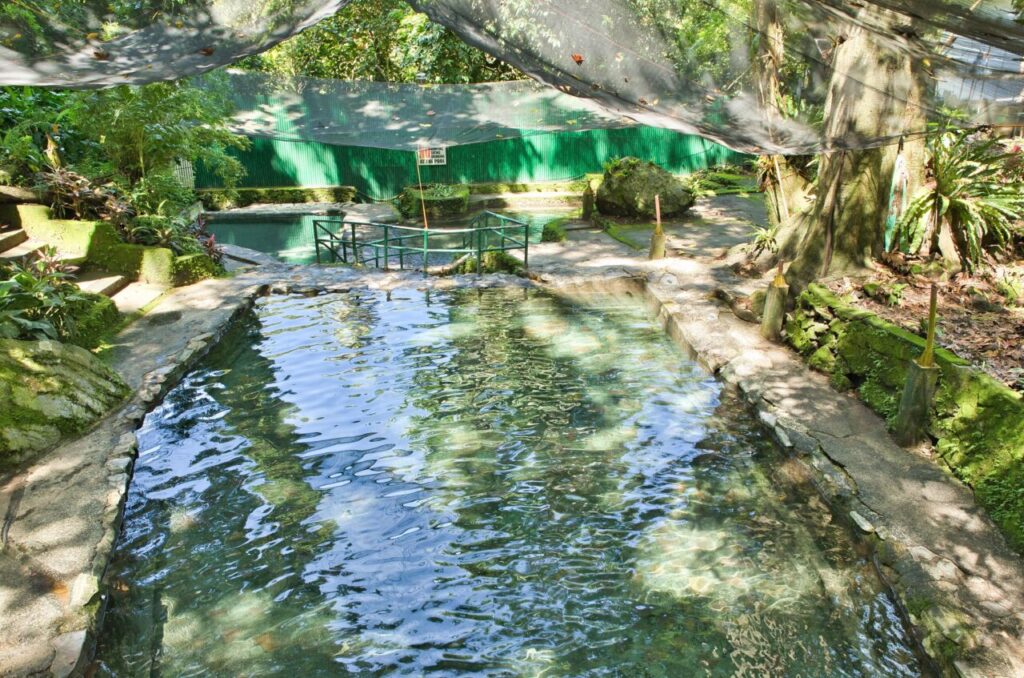
If hot springs are yo’ thing, then you’ll definitely wanna check out Camiguins! Set at the foot of Mount Hibok-Hibok, the ardent hot springs are a popular location with tourists and locals alike, being just a ten minute drive from Mambajao.
They are a series of four man-made pools and natural springs at around 40 degrees celcius and surrounded by lush forest. The warm water and relaxing location is an ideal place to sooth any aching muscles after say, a trek up Mount Hibok-Hibok or an intense diving course. There’s also a cafe there to grab a snack and a drink.
#5 Sand Bar
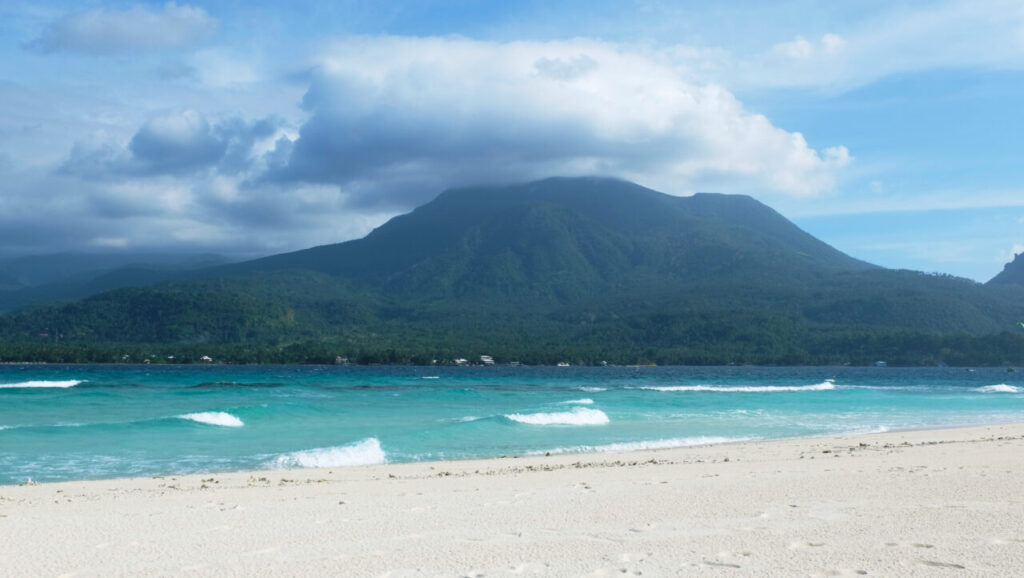
A tiny spit of sand that you can reach via boat for 450 pesos, the main appeal here is the awesome view it gives you back towards Camiguin island and the decent nearby snorkeling. There’s not a single tree or umbrella for shade, so make sure you’ve doused yourself in plenty of sunscreen, if like me, you burn at the nearest whiff of UV – hisssss!
Staying Fit - GYMS
Staying healthy on the road is important…m’kaaaaay? You never known when flying saucers might descend upon the earth en-masse, blow up the Whitehouse, lay waste to humanities most iconic cities and structures and then just float about in a totally half-assed job of not wiping out the remainder of us.
Now, if you’re one of those humans whose not broken a single sweat in months of travel and beer consumption, your chances of out-running those continent obliterating laser beams of death will be even slimmer than the rest of ours! However it ain’t gotta be this way! There’s a few gyms on Camiguin.
My favourite one was Island Gym, which I had virtually all to myself and was decked out with just about every kind of gym gear and machine you could ever imagine all in bright colours across a huge space. There’s no ac, but there is a speaker you can connect your phone to via bluetooth. Nice touch.
Where to Eat
- Paradisio located along the main tourist strip on the north side of the island has some of the highest-quality, tastiest food going – everything from filipino to western dishes as well as plenty of pizza, seafood and fine wine.
- Checkpoint – not to be confused with the military checkpoint where you have to get out your car and stamp your feet on a wet cloth to disinfect yourself (don’t ask me the logic behind this) – this is a small complex of shops, an upstairs restaraunt, a bbq grill and also a place that opens and serve food from 5am onwards, perfect if you have an early morning of trekking, diving or travel ahead of you.
Camiguin Diving Squad DEBRIEFING:
And so the sunsets on yet another Diving Squad destination guide article; in this case the mysterious and seldom travelled Camiguin…the island born of fire!
We’ve covered a lot in this article. First we talked about what divers can see in Camiguin and then we went over the best places to stay in Camiguin, which I’ve expanded upon in a separate article that you can find a link to below.
After this, I went over when to go, then how to get there and other things to do. This was followed by info on gyms and places to eat. And just like that we’re done – now go forth and get ready to dive the fu*k outta Camiguin!
Psssttt! Check out another nearby off-the-beaten-track dive destination: Anda: Bohol’s Hidden Jewel!
